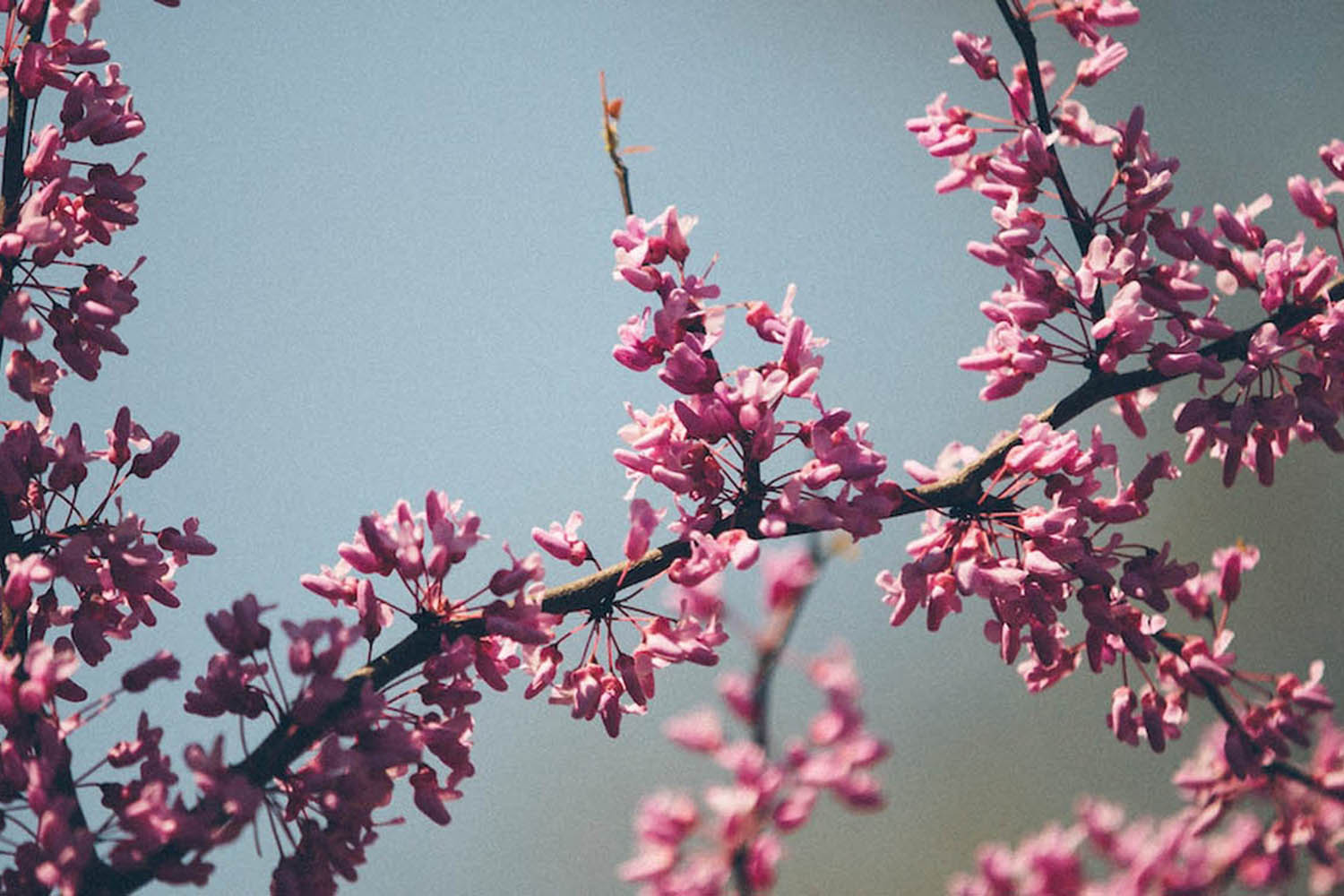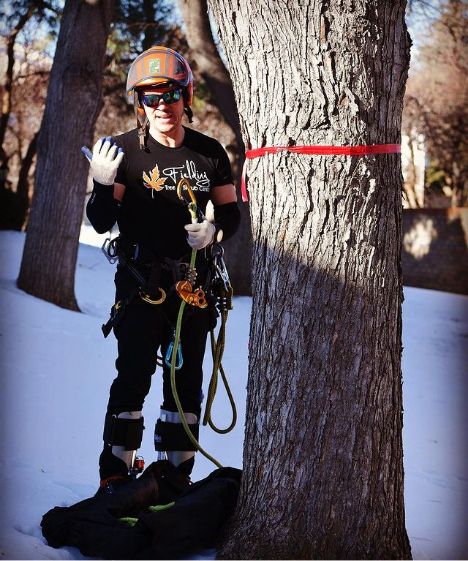You can’t miss the gorgeous pink blooms of the redbud trees that decorate the Denver area. These graceful looking flowering trees add a pop color to any yard. Find out which diseases are harmful to redbud trees and how proper tree protection can keep them looking lustrous and healthy.
Redbud Tree Species Commonly Found in Denver
There are nine known species of the redbud tree and several grow well right here on the Front Range. Redbud trees thrive in the Denver climate due to their heat tolerance, love for full sun, and the ability to grow in many different types of soil. Here are five types of Redbud tree that grow especially well in Denver.
Eastern Redbud
Also called the Judas Tree or Love Tree, this variety of redbud is highly ornamental. Sought after for its showy spring blooms, the Eastern Redbuds fuschia leaves turn yellow in the fall. This species is a deciduous tree which grows well on Denver’s front range. Fully mature, it stands approximately 30 ft. tall and 30 ft. wide. The Eastern Redbud grows at a medium rate, develops a low canopy, and prefers full to partial sun. It is highly tolerant of air pollution, making it a good choice for urban areas as well.
Don Egolf Redbud
This dwarf redbud stands only 9 ft. tall and wide at its maturity, perfect for small spaces! The shockingly pink blooms tightly hug branches that grow upright. When not in bloom, it has dark green heart-shaped leaves. Capable of growing well in many soil types, this redbud species is often desired for its ability to resist disease.
Forest Pansy Redbud
The Forest Pansy is a fast-growing redbud species that produces fabulous color all year long. When not flowering, it produces rich dark purple leaves in summer and vibrant red leaves in the fall. In bloom, it boasts a lovely lilac. The tree naturally spreads into a graceful shape, growing to about 20 ft. tall and 10-15 ft. wide. It is heat tolerant and grows well in zones 5-9.
Lavender Twist Weeping Redbud
Significantly smaller than other redbud varieties, this tree stands about 8 ft. tall and wide when fully grown. Its naturally twisting and cascading branches give this redbud its unique umbrella shape. It produces lovely pink blooms in spring and yellow leaves in the fall. If you love birds, the Lavender Twist Weeping Redbud could be the perfect addition to your lawn because its fragrance attracts hummingbirds and butterflies! This variety grows well in many soil types throughout zones 5-10.
Rising Sun Redbud
A relatively new species, this redbud is known for its fabulous leaf color in addition to its spectacular blooms. Leathery leaves begin to grow in looking apricot, then turn to bright gold, and then to apple green at full maturity. This cycle continues all throughout summer and fall. In spring, the Rising Sun Redbud shows off bright pink blooms that attract hummingbirds and butterflies, and their seeds attract songbirds, goldfinches and cardinals. This species grows to be about 10 ft. tall and 12-15 ft. wide.
How To Identify Denver Redbud Trees
All redbud varieties share common leaf traits, from the length of their stems, to their color, shape, and venation. Follow these simple steps from Garden Guides to identify redbuds in your neighborhood that we have summarized below:
- Leaves typically sprout in the second week of May. Closed buds are a dark red and new leaves appear thin and light reddish-green.
- Look for the heart shape. Redbud leaves are the shape of a round heart, wide at the top, pointy at the bottom.
- Redbuds have five to nine clearly delineated, pale green veins that spring from a common point at the base of the leaf.
- The stem on a redbud is the same length as the leaf.
- Observe leaves in autumn. Leaves on the interior of a redbud tree will turn yellow, while the outer leaves remain green.
- A bonus (not leaf) trait to identify Redbud Trees: Most varieties of Redbuds flower prior to leaf-out. During this time, you can observe if the flowers are pink-purple in color, have five petals, and are in tight clusters that arise directly from their twigs.
Redbud Tree Diseases and Infestations
In order to provide tree protection, you’ll need to know about the diseases and infestations that prey on your rebuds.
Botryosphaeria Canker:
The most devastating of all redbud tree diseases is Botryosphaeria Canker, a fungal disease that can be deadly to redbuds. Botryosphaeria dothidea fungus enters the tree through stressed or injured openings in the bark. As the fungus spreads, sunken cankers form. If left untreated, the cankers eventually girdle the branches, restricting the flow of water and nutrients, and killing that area of the tree. This disease is slow to develop. Be on the lookout for signs of Botryosphaeria Canker:
- cracked, dry or discolored cankers
- one-sided death of branches
- some leaves normal, some discolored
Verticillium Wilt:
Another fungal disease, Verticillium Wilt is a serious threat to redbud trees because no cure exists. The rapidly spreading fungus enters through the redbuds roots and attacks the water transport system, stopping water and nutrients from spreading to all parts of the tree. The tree’s natural defense system will attempt to fight back, but it will only further inhibit water transport. Sadly, the end result is typically death to the entire tree. Signs of Verticillium Wilt include:
- small, discolored leaves that grow poorly
- entire branches quickly or suddenly die
- discolored or streaked sapwood
Leaf Anthracnose:
This leaf and stem fungal disease is a low-level threat to the health of redbuds. It will not cause death but may reduce or stunt growth. Fallen infected leaves can harbor spores that can in turn reinfect new spring growth. At its worst, Leaf Anthracnose can cause defoliation over several seasons. Signs of Leaf Anthracnose include:
- irregularly-shaped or circular areas of dying tissue that forms along the leaf margins or veins
- unsightly brown patches on leaves
- prematurely falling leaves
Redbud Leaf Spot Diseases:
A mainly cosmetic disease, Leaf Spot is caused by a variety of fungi, including Phyllosticta, Cercospora and Gloeosporium. The fungi create unsightly dark leaf spots. Symptoms normally appear in hot, humid weather conditions. Here’s what to look for:
- abnormal discolored spots appear on the foliage
- spots may drop out and leave holes in the leaves
- severely infected leaves may fall from the tree
Redbud Tree Protection and Treatment Options
Are you concerned that your redbud is displaying symptoms of disease? Contact one of our certified arborists ASAP At Fielding Tree Care. We take a four step approach for treating redbud trees:
Step 1: A complimentary on-site disease diagnosis of your trees and/or shrubs. Sending a picture in advance helps speed things up!
Step 2: We work to cure the disease or at least slow it down with the most viable treatment option available for your tree or shrub’s unique situation.
Step 3: A proactive approach is implemented to protect your existing trees from disease or infestation.
Step 4: Unfortunately, sometimes trees and shrubs die, even with our best, safest, and most proven treatment solutions. If your tree or shrub dies, we try to remove the dead plant as soon as reasonably possible. This keeps your property safe from unnecessary infestations and unsightly rotting trees or shrubs.
Proper routine care and maintenance of redbud trees help them grow strong and healthy. When they are in this condition they can naturally fight off infection from harmful fungi. Schedule these seasonal services to keep your redbud trees in tip-top shape.
Watering
Proper watering is a key tree care practice. Redbuds can contract fungi related diseases if their soil becomes too moist, while other damage can occur if there isn’t enough water. We can provide expert consultation for how much water your redbuds need, and how often.
Fertilization
Most redbud species are fairly tolerant of different types of soil, but Denver’s alkaline soil is particularly high in ph. The right fertilizer application balances the soil and gets your redbud trees the perfect nutrient combo they desire. The result is a steady growth and gorgeous blooms.
Tree trimming
Annual pruning and trimming help redbuds keep their beautiful shape and foliage. In addition, our experts have a trained eye and can spot cankers or other possible areas of infection easily. Trimming these away quickly can save your whole tree!
Planting Redbuds in Denver
Mono-planting can increase risk of infection and infestation among trees. Diversifying your landscape can actually keep all your trees and plants healthier. Redbuds can add color and provide privacy to your landscaping. If you’re considering planting a new redbud, there are several factors you need to consider. For best success, follow this guide provided by the Colorado State University Extension:
Soil
Most trees perform best in well-drained soil. Dig a saucer-shaped hole that is 2 to 3 times the width of the root ball. Remove soil from the top of the rootball to expose the root flare, if not visible. When planting, make sure the first root is at or one or two inches above grade.
Color and texture
For variety, plant several kinds of trees if space allows. Through careful selection, you can have flowers, colorful and interesting bark and fruits, varied foliage texture, and fall colors for year-round interest. Coordinate with other plants and elements of your overall landscape design.
Water
Match the plant with the moisture conditions of the site. Low-moisture trees planted in an irrigated lawn grow too fast. On the other hand, trees that require moderate to heavy moisture do poorly in areas where little or no supplemental water can be applied.
Tree Protection
Microclimate sites protected by buildings, fences and larger trees offer greater opportunities for tree protection than open, exposed locations.
Whether you’re looking for planting recommendations, providing tree protection, or removal, our friendly certified arborists are on-hand to help you with all your redbud related needs. Contact us today for your free consultation






